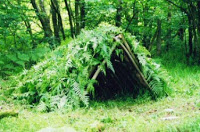Note: This is first in a series by SnoMan
The Berkey Guy, Sponsor
Activist Post
If your plane crashes, your car gets washed away in a mudslide, or your boat sinks and you’re stuck on an unknown coast, your first priority might not be food or water, but an emergency shelter.
It depends on the conditions — weather primarily.
Of course, the best alternative is to get out of the wilderness and back home, but you might have to hunker down before you can leave. In case you do, you’ll need to know how to build an emergency survival shelter.
Assess the situation before you build an emergency shelter
When you find yourself stranded, follow the DAPA procedure:
- Don’t panic. Disorientation, stress, and fear are the enemies of functionality. You can’t reason yourself through a situation without getting control of your emotions.
- Assess your situation. Remain calm; look around. You might not know which direction points home, but you can determine your physical relation to the immediate environment. Are you in a gulley? Are you on high ground? Is it cold? Are you injured? Next, is there anyone with you? If so, determine whether they need help. Then determine what tools you have. What’s in your pocket?
- Plan. Having a plan gives you the means to apply rational thought — it helps keep you mentally stable. Bad morale is lethal; your plan should be designed to guarantee incremental successes. This rewards you with the pleasure of progress. Don’t be too cocky for Baby Steps. Your first success might be something as simple as reaching the vantage point you identified when assessing your situation just moments ago, or identifying North, or taking stock of your tools. If you’re completely befuddled as to what to do, you still must plan. If you can’t think of anything else, determine simply to reach a landmark, like “I’m going to walk 100 yards uphill and see what’s there.” Your goal is always to improve your situation. Be realistic. Your ultimate goal is to get out of the wilderness and get home, but you might not be able to do that right now. If that’s the case, set interim goals that are achievable and improve your situation.
- Act. What you planned, now you must do. Be diligent, but be flexible. Put some effort into carrying out every step of your plan, but revise the plan if necessary to reach your goal. For example, if you have decided to build your shelter against a fallen tree trunk, but find that the ground is drier next to a rock ledge nearby, feel free to move — if you have time. The goal always is to improve your situation.
Understand Your Immediate Shelter Needs
There are four primary considerations in determining your emergency shelter needs: purpose, environment, physical condition, and materials on hand.
- Purpose of a shelter. Always, always keep in mind the purpose of your emergency shelter; you only need to provide basic protection from the elements. If the threat is rain, spend your energy stopping most leaks. If the threat is cold, focus on insulation. If the threat is heat, focus on shade and ventilation. Once you’ve abated the major environmental threat, move on to the next item in your overall plan. Don’t waste time and energy perfecting something that’s good enough.
- Environment. If you’re supremely lucky, you’ll be stranded in an environment that resembles the garden of Eden — food will grow on trees, cold, clean water will bubble out of the ground, you’ll find mossy patches four feet thick for your bed, and the temperature will hover around 80 degrees Fahrenheit day and night. Bet against it, though. Just in case the garden of Eden is hard to find where you’ll be traveling, you should be prepared for a less benign environment. Whenever you travel, it is vitally important to have some information about the weather forecast.
- Physical condition. If you’re in good condition, you can be more aggressive, take a little more hardship, take a little more calculated risk. If you’re injured, sick, or malnourished, your weakened condition means you’ll have less tolerance for exposure. You’ll have to be more careful to provide warmth, to stay dry, and keep your stress level down. Understand your capabilities and limitations.
- Materials on hand. As always, your best bet is to have a well-stocked everyday carry bag. Ideally, you’ll have a ripstop poncho with grommets — you can tie this down for immediate shelter from wind and rain. In five minutes, you have a life-saving shelter. Barring that, consider what you do have, whether it’s snow, leaves, evergreen boughs, bamboo, banana leaves, whatever.

Next article in this series:
Basics of Emergency Shelters
linkwithin_text=’Related Articles:’



Be the first to comment on "Introduction to Emergency Survival Shelters"